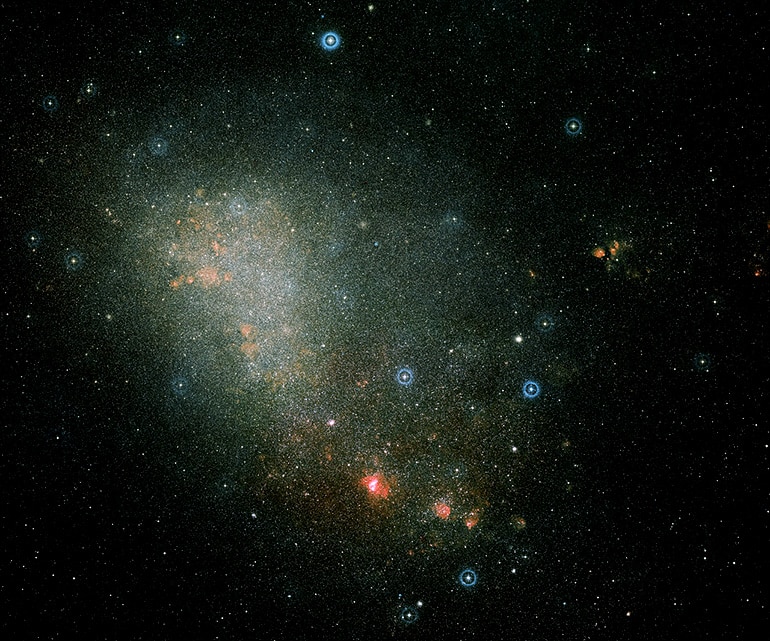New research provides the first unambiguous evidence that two satellite galaxies of the Milky Way recently collided.
If you’re standing in the Southern Hemisphere on a clear night, you can see two luminous clouds offset from the Milky Way. These clouds of stars are satellite galaxies called the Small Magellanic Cloud and the Large Magellanic Cloud, or SMC and LMC.
Using the newly released data from a new, powerful space telescope, astronomers have discovered that the southeast region, or “Wing,” of the Small Magellanic Cloud is moving away from the main body of that dwarf galaxy, the first evidence that the Small and Large Magellanic Clouds collided.

“This is really one of our exciting results,” says lead author Sally Oey, professor of astronomy at the University of Michigan. “You can actually see that the Wing is its own separate region that’s moving away from the rest of the SMC.”
Searching for runaway stars
Together with an international team, Oey and undergraduate researcher Johnny Dorigo Jones were examining the SMC for “runaway” stars, or stars that have been ejected from clusters within the SMC. To observe this galaxy, they were using a recent data release from Gaia, a new, orbiting telescope the European Space Agency launched.
Gaia is designed to image stars again and again over a period of several years in order to plot their movement in real time. That way, scientists can measure how stars move across the sky.
“We’ve been looking at very massive, hot young stars—the hottest, most luminous stars, which are fairly rare,” Oey says. “The beauty of the Small Magellanic Cloud and the Large Magellanic Cloud is that they’re their own galaxies, so we’re looking at all of the massive stars in a single galaxy.”
Examining stars in a single galaxy helps the astronomers in two ways: First, it provides a statistically complete sample of stars in one parent galaxy. Second, this gives the astronomers a uniform distance to all the stars, which helps them measure their individual velocities.
“It’s really interesting that Gaia obtained the proper motions of these stars. These motions contain everything we’re looking at,” Dorigo Jones says. “For example, if we observe someone walking in the cabin of an airplane in flight, the motion we see contains that of the plane, as well as the much slower motion of the person walking.
“So we removed the bulk motion of the entire SMC in order to learn more about the velocities of individual stars. We’re interested in the velocity of individual stars because we’re trying to understand the physical processes occurring within the cloud,” he explains.
Slingshot ejection
Oey and Dorigo Jones study runaway stars to determine how they have been ejected from these clusters. In one mechanism, called the binary supernova scenario, one star in a gravitationally bound, binary pair explodes as a supernova, ejecting the other star like a slingshot. This mechanism produces X-ray-emitting binary stars.
Another mechanism is that a gravitationally unstable cluster of stars eventually ejects one or two stars from the group. This is called the dynamical ejection scenario, which produces normal binary stars. The researchers found significant numbers of runaway stars among both X-ray binaries and normal binaries, indicating that both mechanisms are important in ejecting stars from clusters.
In looking at this data, the team also observed that all the stars within the Wing—that southeast part of the SMC—are moving in a similar direction and speed. This demonstrates the SMC and LMC likely had a collision a few hundred million years ago.
Study contributor Gurtina Besla, an astronomer at the University of Arizona, modeled the collision of the SMC and LMC. She and her team predicted a few years ago that a direct collision would cause the SMC Wing region to move toward the LMC, whereas if the two galaxies simply passed near each other, the Wing stars would be moving in a perpendicular direction. Instead, the Wing is moving away from the SMC, toward the LMC, says Oey, confirming that a direct collision occurred.
“We want as much information about these stars as possible to better constrain these ejection mechanisms,” Dorigo Jones says. “Everyone loves marveling at images of galaxies and nebulae that are incredibly far away. The SMC is so close to us, however, that we can see its beauty in the night sky with just our naked eye. This fact, along with the data from Gaia, allow us to analyze the complex motions of stars within the SMC and even determine factors of its evolution.”
Their results appear in the Astrophysical Journal Letters.
The National Science Foundation funded the research.
Source: University of Michigan



